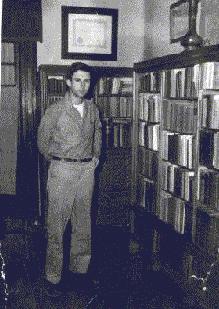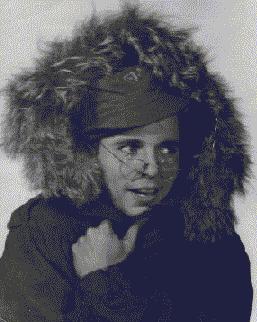Tim Cooney: 1930–1999
John Haberin New York City
A Eulogy
Turn to a review of Tim's philosophy
Everyone, everyone!! Let me call this to order—or as close to order as makes sense for the man we're remembering.
For those who don't know me, I'm John, and for just five minutes I shall be introducing this evening. Legally, I'm Tim Cooney's executor and sole heir to an empty apartment and a few unpaid bills, with Joan Ganz Cooney, his ex,  once more coming to the rescue. But if Tim were here, he'd introduce me, as ever, as his editor.
once more coming to the rescue. But if Tim were here, he'd introduce me, as ever, as his editor.
And in fact I met Tim because I get lost so easily in books. My neighbor down the hall asked me what I was reading one day while waiting for the elevator. Philosophy, I explained. Well, this guy one floor down writes that stuff. And before I knew it, Tim was slipping pages of manuscript under my door every night, wonderful manuscript, and every evening I was returning them.
. . . . .
It was really the first draft of his new book. Already, years ago now, it had taken the form of a Platonic dialogue. Only it wasn't yet with Beth Preddy: it was set in a high school. I miss those kids. I always hoped the young smart-ass was modeled after me.
Tim being Tim, the manuscript loved to talk. All I could contribute as editor was one bit of advice, over and over: Get to the point. Eventually, he must have got tired of that, because he set the book aside, so that it could be reborn—I have to say, without my help—as the challenge to moral thinking we have now, Connections and Disconnections.
I'll never know just when we had time for editing, though. Every evening, it seemed, he was making new friends for me here or at McCormack's across the street. He wasn't just treating me to drinks; he was bringing me out of my shell. Over the years he talked me through shyness, loneliness, and social failures. He stimulated me to become a writer myself. I am as grateful for his generosity as for the intellectual spark he still gives.
. . . . .
I also watched him drink himself to death. We're here not to idealize Tim, but to remember him. I saw him allowed into fewer bars, less and less the center of the crowd at others. As his cycle of manic drunks and dry, reclusive weeks intensified,  there were fewer windows of opportunity in there to socialize. His hands shook almost all the time, and I no longer knew for sure whether from drinking or from alcohol withdrawal.
there were fewer windows of opportunity in there to socialize. His hands shook almost all the time, and I no longer knew for sure whether from drinking or from alcohol withdrawal.
He was hospitalized more than once in the last couple of years. Each time he had me run to find him a laptop, for he knew as well as anyone that this book was a race against death. His last week alive was the first time since I knew him that he was not writing, without a book ahead. He called it a vacation, but he had to admit that he was also at sea.
But up to the end, Tim was there for me, nurturing and challenging. Only a few weeks ago, when I broke my leg, he was the first one over, with a cane—and a six-pack. He was still telling stories, and to this day his doctor honestly believes he went to China this year on a mission of human rights. We argued over his philosophy again the day before his final hospitalization, and I still argue with him in my head every single day.
. . . . .
I'll just end by reminding us why we're here. Timothy Jeffrey Cooney died of a heart attack ten days ago, on a Wednesday at 3:10 p.m., at NYU hospital. He was buried this week at Woodlawn cemetery—as he put it, as far from his mother as possible.
He was the man who published the scathing essay "How to Build a Slum" and five books of philosophy but whose favorite of his own was unpublished porn fiction. He was the man who worked in two city administrations for civil rights and against poverty but had the candor to call one of his posts a waste of money and to shut down another. He was the man who withdrew from public life decades ago, to work alone in his apartment, but who was the most social animal I've ever met. He was the man who could be 86'd from most every joint in the neighborhood but who, over the course of this evening, will have filled a bar with friends.
There's another answer, too, to why we're here. I mean why we're here rather than in a church or at Gannon's funeral home, why his burial was without any of us invited, just between him and his two parents, and they had no choice about attending. One reason is that Tim had no patience for rites and rituals. Although he claimed even in his last book to believe in God, one can see his entire life's work as a philosopher as getting God and organized religion out of morality. Another reason is that Tim loved it here. He'd be thrilled by the chance one last time to buy us all drinks.
. . . . .
Another is who we are. Tim had the ability to reach out to everyone, and perhaps all we have in common is that we love to argue. If I kept this eulogy going any longer, thirteen people including columnists for three New York papers would start interrupting.
So I won't. Just one final reason we're here. When I sorted through Tim's apartment last weekend, I found only one, utterly filthy change of clothes—but a ton of memorabilia. And that pretty much sums it up: a life of few possessions but plenty of memories.
I'd like to suggest we just break up and share those memories. After Beth, his last girlfriend, says a few words, let's gather in groups as we like, to listen and to share. I'm looking forward to some good stories.

This eulogy was delivered Saturday, July 17, 1999, at Caliban, a bar and restaurant in New York City. Turn to a review of Tim's philosophy.




